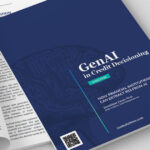Before fixing our gaze entirely on the future, let’s review the trends that dramatically affected the financial industry in the past calendar year. Learning how to harness big data and make it useful, complying with EMV, and understanding the impact of mobile wallets and disruptive competitors were just a few that made headlines.
Advanced Analytics
In 2015, the financial industry made a point to enhance the customer experience by leveraging massive amounts of data from phone calls, emails, mobile apps, ATMs, and websites. For instance, analyzing Twitter comments posted by customers regarding their experience at the branch offers rich data sets. Likewise, photos posted on Instagram welcoming a first child into the world can prompt a personalized email initiating discussions on the importance of life insurance and college funds. Aggregating and using this data to predict consumer tendencies provides a custom-made banking experience.
Chief marketing officer Bryan Clagget of Geezeo wrote, “The financial services industry will move beyond omnichannel banking and more fully realize that financial institutions can use data and interactions, regardless of channel, to genuinely connect with consumers on a more emotional level. This includes predicting consumer needs and serving in more of an advisor role.”
Financial institutions (FIs) recognize the divide between the bank and consumer can be bridged with advanced analytics; once banks understand their customers, they can make the right offer at the right time.
EMV Technology
Even though EMV was developed in 1994 by Europay, MasterCard, and Visa, the U.S. was the last major market to adopt this technology as their payment standard. Regulations forced the issue, and the deadline for issuers and retailers to comply was October 1, 2015, or face liability for fraud losses. The transition is still underway.
In essence, EMV is a global standard designed to deliver several benefits including:
Eliminating Skimming & Reducing Fraud – EMV bankcards come equipped with a security chip designed to prevent fraud. Rather than swiping your card, you insert it into the POS terminal. The chip provides a distinctive identifier and transaction code that cannot be reproduced or replicated helping banks spot counterfeit cards more easily.
Worldwide Usability – Since EMV technology is already used in more than 80 countries, the implementation in the U.S. will provide interoperability throughout the world to consumers.
Enabling Various Payment Options – The demand for payment versatility was answered by permitting contact EMV, contactless EMV, mobile EMV, or all of the above. The intent was to maximize customer satisfaction by providing a service that enables them to pay how they see fit.
The integration of EMV technology in the U.S. continues to be a tedious process due to roughly 67% of merchants lacking compatible POS terminals; it is projected to take roughly five years to fully implement this technology. It will be interesting to see what bloggers and financial professionals have to say about EMV technology in their 2016 predictions, since the transition has faced several challenges.
Mobile Wallet
With the rise of customer centric banking, the mobile wallet phenomenon has evolved into a major force in the financial industry. Apple Pay, along with Google Wallet and Square, are redefining the payment space, so banks are faced with the decision to follow suit by partnering or launching their own mobile wallet.
Al Dominick, president of Bank Director said, “Banks have to compete with major retailers and mobile payment solutions. New technologies mean banks have new competitors they never considered on the same playing field.”
Fear not FIs! A recent poll by ING International Survey concluded that customers would rather use their bank’s mobile wallet as opposed to a third-party application. Here are the statistics extrapolated from the 10,169 users involved in the survey:
- 84% of consumers with a mobile phone trust their FI most to provide a mobile wallet application.
- 16% were split among up-and-coming tech companies, suppliers, social media companies, and other banks.
- Only 5% trusted companies like Apple and Google to provide a wallet app over their own bank.
Financial Disruptors
The rapid development of new technologies coupled with tech savvy consumers is fundamentally changing the banking industry. New tech startups are recognizing that banks often fall behind in regard to customer experience; as a result startups are focusing on providing technology that addresses consumers’ pain points with their FIs. They can quickly inundate the market with simple, yet intuitive tools that flaunt transparency and ultimately foster positive customer experiences. This puts the financial industry under fire because their customers wonder why their bank can’t provide the same.
Traditional banks can be hampered by legacy infrastructure, the complexity of digital channels, and the pace in which today’s environment changes. However, they can implement the strategies of startups by championing partnerships that benefit both the business and customer, minimizing the likelihood of defectors.
Change is never easy, especially for financial organizations with complex hierarchies. In order to stay relevant, FIs understand they must build a culture that puts customers first and focus on providing the tools and services they desire.
Looking Towards 2016
With 2016 predictions just around the corner, it will be interesting to see what trends bloggers and business forecasters believe will impact the market next.
All of us at Zoot wish our readers a prosperous new year.





